Hoo boy — with Convergence done. you’d think there’d be a chance to relax in the early-summer heat (and, weirdly, rain), but instead we get nine Secret Wars books from Marvel, plus five DC first issues (and major turning-point episodes of Action and Justice League), along with the usual batch of cool indy stuff too. Let’s run them down:
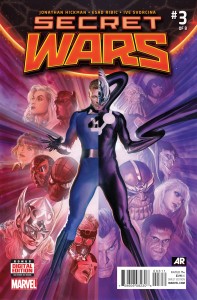 Secret Wars #3 (of 8) — Writer: Jonathan Hickman; Art: Esad Ribic; Colors: Ive Svorcina
Secret Wars #3 (of 8) — Writer: Jonathan Hickman; Art: Esad Ribic; Colors: Ive Svorcina
Secret Wars: Years of Future Past #1 (of 4) — Writer: Marguerite Bennett; Art: Mike Norton; Colors: FCO Plascencia
Secret Wars: X-Tinction Agenda #1 (of 3) — Writer: Marc Guggenheim; Art: Carmine Di Giandomenico; Colors: Nolan Woodard
Secret Wars: The Amazing Spider-Man: Renew Your Vows #1 (of 4) — Writer: Dan Slott; Pencils: Adam Kubert; Inks: John Dell; Colors: Justin Ponsor
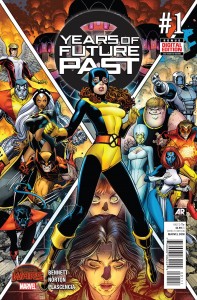 Secret Wars: Armor Wars #1 (of 4) — Writer: James Robinson; Art: Marcio Takara; Colors: Esther Sanz
Secret Wars: Armor Wars #1 (of 4) — Writer: James Robinson; Art: Marcio Takara; Colors: Esther Sanz
Secret Wars: Future Imperfect #1 ( of 4) — Writer: Peter David; Art: Greg Land; Colors: Nolan Woodard
Secret Wars: Giant-Size Little Marvel: A vs. X #1 (of 3) — Writer/Artist: Skottie Young; Colors: Jean-Francois Beaulieu
Secret Wars: Battleworld #2 (of 4) — (First Story): Writer: David Walker; Art: J.J. Kirby; Colors: Matt Milla (Second Story): Writer: Donny Cates; Art: Marco Turini; Colors: Frank D’Armata
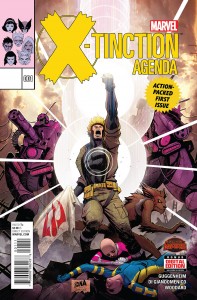 Secret Wars: Master of Kung Fu #2 (of 4) — Writer: Haden Blackman; Pencils: Dalibor Talajic; Inks: Goran Sudzuka; Colors: Miroslav Mrva
Secret Wars: Master of Kung Fu #2 (of 4) — Writer: Haden Blackman; Pencils: Dalibor Talajic; Inks: Goran Sudzuka; Colors: Miroslav Mrva
Although there are some major differences, the core idea of Secret Wars matches Convergence: a planet with cobbled-together bits of a comic company’s long history, ruled by a major villain — although Victor Doom is a lot more benevolent than Brainiac/Deimos were over in the DC world — giving creators an opportunity to revisit various eras and characters. Secret Wars #3 reveals more about how this happened (although reading the last two years’ worth of Avengers and New Avengers would help), revealing that Doom, Dr. Strange and the Molecule Man, at the end of time and  space and with the multiverse almost destroyed, pulled together everything that was left, and Doom became the god he’d always aspired to be. There’s a casual mention that this happened eight years ago, and that only a few of the planet’s inhabitants remember it — but now, two unexpected ships of refugees from the earlier universes have arrived: one with Thanos and other bad guys, and one with Reed Richards and a crew of good guys. This is all done with some style (Ribic’s art has a solid sense of composition, and a knack for characters’ faces and gestures, that helps to make it look good) and big-scale storytelling; you can’t accuse writer Hickman of thinking
space and with the multiverse almost destroyed, pulled together everything that was left, and Doom became the god he’d always aspired to be. There’s a casual mention that this happened eight years ago, and that only a few of the planet’s inhabitants remember it — but now, two unexpected ships of refugees from the earlier universes have arrived: one with Thanos and other bad guys, and one with Reed Richards and a crew of good guys. This is all done with some style (Ribic’s art has a solid sense of composition, and a knack for characters’ faces and gestures, that helps to make it look good) and big-scale storytelling; you can’t accuse writer Hickman of thinking  small, and he knows just the right lines to end a scene (when Reed can’t believe that Stephen Strange let Doom take over the planet, Strange says, simply, “…He is very very good at playing god.” Aaaand… cut). Two of the tie-in series this week involve X-Men continuity: Years of Future Past has the near-future timeline from “Days of Future Past,” in Uncanny X-Men #141 and 142, with mutants rounded up in camps, patrolled by Sentinels — although the older Wolverine is still around, so it isn’t from quite the same story. Once you get past the disappointment that it’s not by Chris Claremont and John Byrne, it’s a well-told-enough beginning, with that charge from seeing
small, and he knows just the right lines to end a scene (when Reed can’t believe that Stephen Strange let Doom take over the planet, Strange says, simply, “…He is very very good at playing god.” Aaaand… cut). Two of the tie-in series this week involve X-Men continuity: Years of Future Past has the near-future timeline from “Days of Future Past,” in Uncanny X-Men #141 and 142, with mutants rounded up in camps, patrolled by Sentinels — although the older Wolverine is still around, so it isn’t from quite the same story. Once you get past the disappointment that it’s not by Chris Claremont and John Byrne, it’s a well-told-enough beginning, with that charge from seeing  second-generation characters and trying to identify who their parents were; take a minute and click on that great-looking Art Adams cover thumbnail here to appreciate it in its larger version. X-Tinction Agenda is from that ’90s X-crossover involving the mutant nation of Genosha, with Wolfsbane and Havok having relocated there to help the country, but now battling a mutant virus that’s killing the population and causing riots — their solution involves taking a team to New York and battling the other X-Men, because, hey, conflict; it’s all OK, and more so if you have fond memories of that period of X-history. Amazing Spider-Man: Renew Your Vows has a
second-generation characters and trying to identify who their parents were; take a minute and click on that great-looking Art Adams cover thumbnail here to appreciate it in its larger version. X-Tinction Agenda is from that ’90s X-crossover involving the mutant nation of Genosha, with Wolfsbane and Havok having relocated there to help the country, but now battling a mutant virus that’s killing the population and causing riots — their solution involves taking a team to New York and battling the other X-Men, because, hey, conflict; it’s all OK, and more so if you have fond memories of that period of X-history. Amazing Spider-Man: Renew Your Vows has a  Peter Parker still married to Mary Jane, and with a daughter, and is about him juggling his two great responsibilities: family and society; with longtime Spider-writer Dan Slott and Adam Kubert art, it’s one of the best of these for the week. Armor Wars is, duh, Iron Man, but isn’t from the two previous story arcs with that name; instead, it’s from the future of 2020 where Arno Stark is the bad guy, and everyone’s ultra-technological; it’s interesting because of the contrast between the high-tech setting and Takara’s loose, organic style, and is a good example of why I’ve started listing colorists in the credits: Esther Sanz’s vibrant palette is the catalyst that lets the two
Peter Parker still married to Mary Jane, and with a daughter, and is about him juggling his two great responsibilities: family and society; with longtime Spider-writer Dan Slott and Adam Kubert art, it’s one of the best of these for the week. Armor Wars is, duh, Iron Man, but isn’t from the two previous story arcs with that name; instead, it’s from the future of 2020 where Arno Stark is the bad guy, and everyone’s ultra-technological; it’s interesting because of the contrast between the high-tech setting and Takara’s loose, organic style, and is a good example of why I’ve started listing colorists in the credits: Esther Sanz’s vibrant palette is the catalyst that lets the two 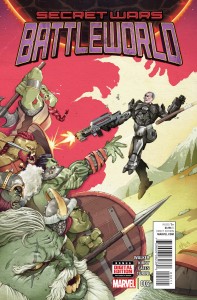 opposites combine so successfully. Future Imperfect is successful, too, mostly because it’s the only book that brings back its era’s original creator, and because Greg Land’s so good at delivering David’s high-energy suspense story (he’s a worthy addition to the lengthy honor roll of artists who’ve done some of their best work on David Hulk scripts). Best book of the week, though, has to go to Giant-Size Little Marvel: A vs. X #1: all you fans who go nuts for Skottie Young cover variants? This has a Young cover, and twenty pages of his story and art featuring a dozen-plus of his Peanuts-age Marvel characters; why are
opposites combine so successfully. Future Imperfect is successful, too, mostly because it’s the only book that brings back its era’s original creator, and because Greg Land’s so good at delivering David’s high-energy suspense story (he’s a worthy addition to the lengthy honor roll of artists who’ve done some of their best work on David Hulk scripts). Best book of the week, though, has to go to Giant-Size Little Marvel: A vs. X #1: all you fans who go nuts for Skottie Young cover variants? This has a Young cover, and twenty pages of his story and art featuring a dozen-plus of his Peanuts-age Marvel characters; why are 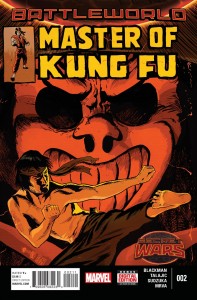 you not getting this comic? Battleworld is an anthology book with two ten-page stories: the first has Howard the Duck and Blade against vampires on the Duckworld section of the Secret Wars planet, and has Walker and Kirby doing homage to Gene Colan, the longtime artist most associated with both of those characters. Finally, Master of Kung Fu is the second installment about the martial-arts-characters section of Battleworld; it’s OK, but was another book that made me wish it had been by an older-school crew: Doug Moench and Paul Gulacy, the writer and artist most associated with Shang-Chi’s glory days.
you not getting this comic? Battleworld is an anthology book with two ten-page stories: the first has Howard the Duck and Blade against vampires on the Duckworld section of the Secret Wars planet, and has Walker and Kirby doing homage to Gene Colan, the longtime artist most associated with both of those characters. Finally, Master of Kung Fu is the second installment about the martial-arts-characters section of Battleworld; it’s OK, but was another book that made me wish it had been by an older-school crew: Doug Moench and Paul Gulacy, the writer and artist most associated with Shang-Chi’s glory days.
 Groot #1 — Writer: Jeff Loveness; Art/Colors: Brian Kesinger
Groot #1 — Writer: Jeff Loveness; Art/Colors: Brian Kesinger
The Unbeatable Squirrel Girl #6 — Writer: Ryan North; Art: Erica Henderson; Colors: Rico Renzi
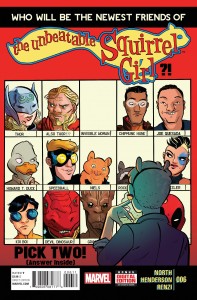 Spider-Woman #8 — Writer: Dennis Hopeless; Pencils: Javier Rodriguez; Inks: Alvaro Lopez; Colors: Muntsa Vicente
Spider-Woman #8 — Writer: Dennis Hopeless; Pencils: Javier Rodriguez; Inks: Alvaro Lopez; Colors: Muntsa Vicente
All-New X-Men #41 — Writer: Brian Michael Bendis; Art: Mahmud Asrar; Colors: Marte Gracia
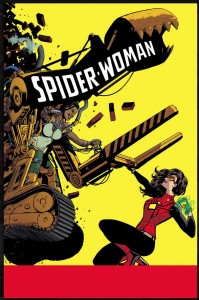 House of Hem #1 (of 1) — Creator: Fred Hembeck
House of Hem #1 (of 1) — Creator: Fred Hembeck
Quite a few other decent Marvel books: Groot is for fans of Rocket Raccoon, with the same blend of attractive cartoony style and sly wit (with a compelling, otherworldly main cover by Declan Shalvey and Jordie Bellaire). The Unbeatable Squirrel Girl, behind its Avengers #221 tribute cover, is a take on the seemingly-benevolent-new-super-friends-who-turn-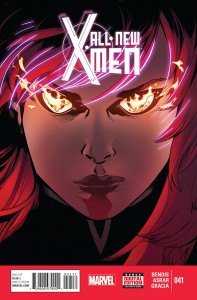 out-to-be-something-different story, and is one of the bright, shiny new faces of modern Marvel books; Spider-Woman is from the same school, with its reader-friendly-but-smart scripts and its brisk, attractive art and coloring. All-New X-Men is, I think, the last Bendis X-book in his run (except for the giant Uncanny X-Men #600 in four months), and, as the cover suggests, shows the younger Jean Gray coming into her own. House of Hem
out-to-be-something-different story, and is one of the bright, shiny new faces of modern Marvel books; Spider-Woman is from the same school, with its reader-friendly-but-smart scripts and its brisk, attractive art and coloring. All-New X-Men is, I think, the last Bendis X-book in his run (except for the giant Uncanny X-Men #600 in four months), and, as the cover suggests, shows the younger Jean Gray coming into her own. House of Hem 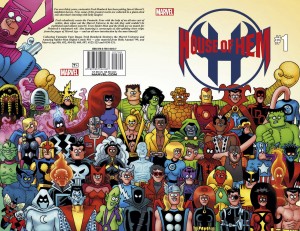 references Fred Hembeck, the bigfoot fan cartoonist whose unique style and affection for the Marvel characters made him the Skottie Young of the 1980s; it collects a bunch of his work on Marvel books from that era into a more-than-100-page comic for $7.99, and is a bargain if you’ve never encountered his stuff before (and another cover you have to click on to fully appreciate).
references Fred Hembeck, the bigfoot fan cartoonist whose unique style and affection for the Marvel characters made him the Skottie Young of the 1980s; it collects a bunch of his work on Marvel books from that era into a more-than-100-page comic for $7.99, and is a bargain if you’ve never encountered his stuff before (and another cover you have to click on to fully appreciate).
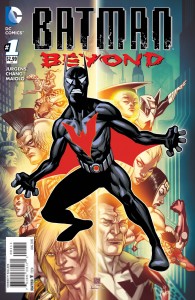 Batman Beyond #1 — Writer: Dan Jurgens; Art: Bernard Chang; Colors: Marcelo Maiolo
Batman Beyond #1 — Writer: Dan Jurgens; Art: Bernard Chang; Colors: Marcelo Maiolo
Bat-Mite #1 — Writer: Dan Jurgens; Pencils: Corin Howell; Inks: Howell and Andres Ponce; Colors: Mike Atiyeh
Bizarro #1 — Writer: Heath Corson; Art: Gustavo Duarte and Bill Sienkiewicz; Colors: Pete Pantazis
 Midnighter #1 — Writer: Steve Orlando; Pencils: ACO; Inks: ACO with Hugo Petrus; Colors: Romulo Fajardo, Jr.
Midnighter #1 — Writer: Steve Orlando; Pencils: ACO; Inks: ACO with Hugo Petrus; Colors: Romulo Fajardo, Jr.
The Omega Men #1 — Writer: Tom King; Art: Barnaby Bacenda; Colors: Romulo Fajardo, Jr.
Five DC first issues. Batman Beyond takes up where the Futures End weekly series left off: with Tim Drake now in the title role, battling Brother Eye and his techno-organic  hybrid-zombie versions of most of the mainstream heroes in a future that’s a couple of decades removed from ours (and DC’s). Jurgens turns in a solid script here, and so too for the much-lighter Bat-Mite; he and artist Corin Howell make that book a kind of Animaniacs version of the DCU, complete with sexy nurses and Looney-Tunes-style meta-commentary. It’s interesting that DC is releasing this the same week as the similar-in-concept Bizarro, although that book offers more of a mismatched-buddy-comedy road trip, as the imperfect, opposite-thinking Superman clone and Jimmy Olson play the big dumb innocent guy and his
hybrid-zombie versions of most of the mainstream heroes in a future that’s a couple of decades removed from ours (and DC’s). Jurgens turns in a solid script here, and so too for the much-lighter Bat-Mite; he and artist Corin Howell make that book a kind of Animaniacs version of the DCU, complete with sexy nurses and Looney-Tunes-style meta-commentary. It’s interesting that DC is releasing this the same week as the similar-in-concept Bizarro, although that book offers more of a mismatched-buddy-comedy road trip, as the imperfect, opposite-thinking Superman clone and Jimmy Olson play the big dumb innocent guy and his 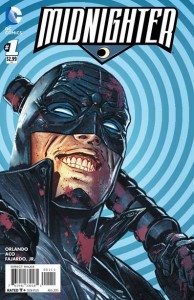 feisty, smart-ass little sidekick (the Of Mice and Men parody should be their first annual…). Midnighter hits almost exactly the same three beats as the last three series featuring that Batman clone: yes, he can predict your every move in a fight before it begins; yes, he doesn’t mind beating your head in with a baseball bat if he decides you deserve it; yes, he’s gay; the art, by “ACO,” has a detailed eye and an interesting imbedded-panel style sort of like
feisty, smart-ass little sidekick (the Of Mice and Men parody should be their first annual…). Midnighter hits almost exactly the same three beats as the last three series featuring that Batman clone: yes, he can predict your every move in a fight before it begins; yes, he doesn’t mind beating your head in with a baseball bat if he decides you deserve it; yes, he’s gay; the art, by “ACO,” has a detailed eye and an interesting imbedded-panel style sort of like 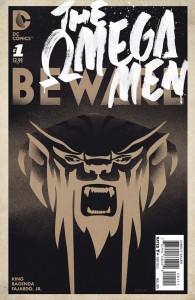 Paul Azaceta over in Outcast, but that may not be enough to keep this book from suffering the same fate as all its previous incarnations. Omega Men might have had the most arresting of all the previews in the Convergence books, with the Omega Men as ISIL-style terrorists broadcasting their seeming-execution of Kyle Raynor, and that tone is extended and deepened cleverly here; the art uses a nine-panel Watchmen layout, brisk and effective, that opens up into a broader screen as the action demands it, and this is a confident, sophisticated, gut-punchy little comic that may or may not find an audience, but definitely deserves one.
Paul Azaceta over in Outcast, but that may not be enough to keep this book from suffering the same fate as all its previous incarnations. Omega Men might have had the most arresting of all the previews in the Convergence books, with the Omega Men as ISIL-style terrorists broadcasting their seeming-execution of Kyle Raynor, and that tone is extended and deepened cleverly here; the art uses a nine-panel Watchmen layout, brisk and effective, that opens up into a broader screen as the action demands it, and this is a confident, sophisticated, gut-punchy little comic that may or may not find an audience, but definitely deserves one.
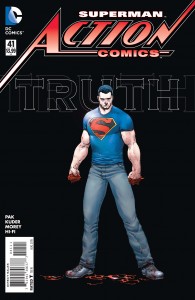 Action Comics #41 — Writer: Greg Pak; Art: Aaron Kuder; Colors: Tomeu Morey and Hi-Fi
Action Comics #41 — Writer: Greg Pak; Art: Aaron Kuder; Colors: Tomeu Morey and Hi-Fi
Justice League #41 — Writer: Geoff Johns; Art: Jason Fabok; Colors: Brad Anderson
Two mainstream DC books that offer the beginnings of major stories: Action is our first full look at the greatly-depowered Superman who’s been exposed to the world as Clark Kent (in a Lois-Lane-written reveal) and is on the run 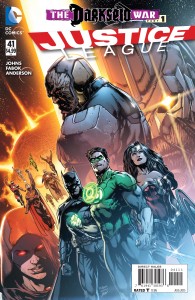 from the authorities; it does its job of making me care about the Man of Steel (more so than anyone on this title since its Grant-Morrison-written New-52 debut, a run that covered some of the same themes) and want to read the next issue. Justice League kicks off a big Darkseid story, the kind of multi-issue widescreen saga that brings out Johns’s best fannish-friendly qualities; he’s good at getting the most out of his artists, and gives Fabok plenty of opportunities for dramatic panels and poses here. If you’re at all a fan of the main DC characters, you need to be reading this book.
from the authorities; it does its job of making me care about the Man of Steel (more so than anyone on this title since its Grant-Morrison-written New-52 debut, a run that covered some of the same themes) and want to read the next issue. Justice League kicks off a big Darkseid story, the kind of multi-issue widescreen saga that brings out Johns’s best fannish-friendly qualities; he’s good at getting the most out of his artists, and gives Fabok plenty of opportunities for dramatic panels and poses here. If you’re at all a fan of the main DC characters, you need to be reading this book.
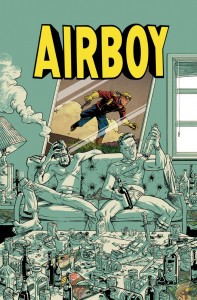 Airboy #1 — Writer: James Robinson; Art/Colors: Greg Hinkle
Airboy #1 — Writer: James Robinson; Art/Colors: Greg Hinkle
Broken World #1 — Writer: Frank Barbiere; Art: Christopher Peterson; Colors: Marissa Louise
The Wicked and the Divine #11 — Writer: Kieron Gillen; Art: Jamie McKelvie; Colors: Matthew Wilson
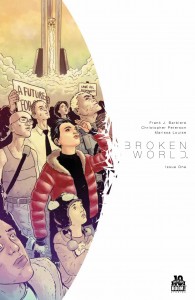 Autumnlands #6 — Writer: Kurt Busiek; Art: Benjamin Dewey; Colors: Jordie Bellaire
Autumnlands #6 — Writer: Kurt Busiek; Art: Benjamin Dewey; Colors: Jordie Bellaire
Rat God #5 (of 5) — Creator: Richard Corben
Minimum Wage: So Many Bad Decisions #2 (of 6) — Creator: Bob Fingerman
 War Stories #9 — Writer: Garth Ennis; Art: Tomas Aria; Colors: Digikore Studios
War Stories #9 — Writer: Garth Ennis; Art: Tomas Aria; Colors: Digikore Studios
The most noteworthy of this week’s indy books. Airboy is the most interesting: a very meta look at two comics creators, James Robinson and Greg Hinkle, as they get an assignment to reboot the Golden-Age character Airboy and, devoid of inspiration, stumble through an evening of drinking, drugs and ill-considered sex, only to have the  inspiration show up unexpectedly the next morning. It’s got a raunchy take-no-prisoners tone and a refreshingly-direct (and adult) sense of humor (although it loses a point for name-checking Hunter S. Thompson too soon), and is just the sort of rude romp that might become an unexpected hit. Broken World, the other debut, is yet another Image SF title, about an Earth facing an extinction-level asteroid impact, and evacuating the planet — except for those deemed unfit to be saved, who are left behind. Barbiere, probably best known for Five Ghosts, knows how to set up
inspiration show up unexpectedly the next morning. It’s got a raunchy take-no-prisoners tone and a refreshingly-direct (and adult) sense of humor (although it loses a point for name-checking Hunter S. Thompson too soon), and is just the sort of rude romp that might become an unexpected hit. Broken World, the other debut, is yet another Image SF title, about an Earth facing an extinction-level asteroid impact, and evacuating the planet — except for those deemed unfit to be saved, who are left behind. Barbiere, probably best known for Five Ghosts, knows how to set up 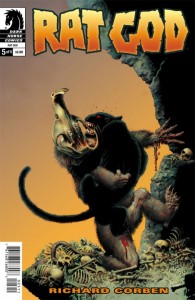 an intriguing plot, although the science here is tenuous at best (“Powered by gravity wells using the asteroid’s own massive force, the space elevators allowing us to flee en masse are a truly momentous achievement for humanity.” Um, yeah, as someone raised on ’50s and ’60s sf, with actual hard science involved, I have to say that sentence makes no sense whatsoever; it’s bs, not sf). If you can get past the gobbledegook in the setup, though, the end result is OK, with a twist ending that sets up the rest of the series nicely. The other ongoing books here are their usual well-produced selves: The Wicked and the Divine takes readers
an intriguing plot, although the science here is tenuous at best (“Powered by gravity wells using the asteroid’s own massive force, the space elevators allowing us to flee en masse are a truly momentous achievement for humanity.” Um, yeah, as someone raised on ’50s and ’60s sf, with actual hard science involved, I have to say that sentence makes no sense whatsoever; it’s bs, not sf). If you can get past the gobbledegook in the setup, though, the end result is OK, with a twist ending that sets up the rest of the series nicely. The other ongoing books here are their usual well-produced selves: The Wicked and the Divine takes readers 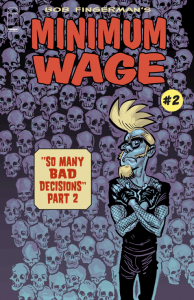 on a roller-coaster that ends very badly; the front-cover image, and the back-cover quote (“No one gets a happy ending”) warn us, but the impact is still surprising; I finished the book and said, out loud, “You bastards,” a tribute to Gillen and McKelvie’s ability to suck me into their story. Autumnlands ends its first arc with a big battle, some closure and some frustrating cliffhangers leading into the next installment in a few months; it’s been a very good high-fantasy series, with Dewey’s art rendering its anthropomorphic characters beautifully and Busiek knowing exactly how to spin his tale to its best effect; if you
on a roller-coaster that ends very badly; the front-cover image, and the back-cover quote (“No one gets a happy ending”) warn us, but the impact is still surprising; I finished the book and said, out loud, “You bastards,” a tribute to Gillen and McKelvie’s ability to suck me into their story. Autumnlands ends its first arc with a big battle, some closure and some frustrating cliffhangers leading into the next installment in a few months; it’s been a very good high-fantasy series, with Dewey’s art rendering its anthropomorphic characters beautifully and Busiek knowing exactly how to spin his tale to its best effect; if you 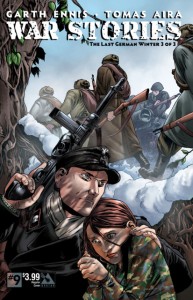 haven’t been following this, put the book collection in a few weeks on your have-to-buy list. Rat God also offers a conclusion, as Corben wraps up his Lovecraftian saga with a big fight (the cat god/rat god one on the cover) and an untypically-happy ending. Meanwhile, Minimum Wage continues to offer Bob Fingerman’s well-realized New York City characters struggling to make a living, and navigate their complicated love lives, in the 1990s, and War Stories continues its always-top-notch Garth Ennis series with a conclusion to his typically-well-researched WW II German-refugees-chased-by-Russians tale, dark and hopeful in just about equal measure, and as good a place as any to end this week’s list.
haven’t been following this, put the book collection in a few weeks on your have-to-buy list. Rat God also offers a conclusion, as Corben wraps up his Lovecraftian saga with a big fight (the cat god/rat god one on the cover) and an untypically-happy ending. Meanwhile, Minimum Wage continues to offer Bob Fingerman’s well-realized New York City characters struggling to make a living, and navigate their complicated love lives, in the 1990s, and War Stories continues its always-top-notch Garth Ennis series with a conclusion to his typically-well-researched WW II German-refugees-chased-by-Russians tale, dark and hopeful in just about equal measure, and as good a place as any to end this week’s list.



